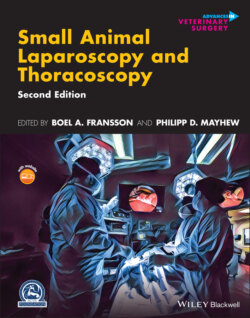Читать книгу Small Animal Laparoscopy and Thoracoscopy - Группа авторов - Страница 28
Adding Minimally Invasive Surgery to a Surgeon's Repertoire
ОглавлениеWithin the last decade, veterinary medicine has started to increasingly recognize the importance of skills development for surgeons who want to incorporate minimally invasive surgery (MIS) in their clinical practice.
Even for surgeons with considerable expertise in traditional open surgery, it often becomes readily apparent that some laparoscopic skills are distinctly different from those of open surgery. The challenges and differences include the use of long instruments, which magnifies any tremor and limits tactile sensation, often referred to as haptic feedback. When the instrument movement is limited by a portal into the body cavity, the surgeon needs to handle the resulting fulcrum effect and the loss of freedom to simply alter an approaching angle. But even more important, the normal binocular vision becomes monocular; as a result, the associated depth perception is lost. Other challenges include the loss of a readily accessible bird's eye view of the entire body cavity. The advantage of magnification may be perceived as offset by a reduced field of view, and any instrument activity outside the view becomes a liability.
Understandably, a surgery team with extensive experience of open procedures may initially be reluctant to take on some of the challenges of MIS. This may be especially conspicuous in small animal laparoscopy, in which the conventional surgical approach provides easy access to all intraabdominal organs. A budding small animal laparoscopic surgeon may meet resistance from referring veterinarians and even staff members when converting open procedures to laparoscopic because costs and surgery time, at least initially, tend to be higher. Educating the referral base, clients, and staff in the advantages of laparoscopy may alleviate but not completely remove the initial resistance.
The surgeon's transition from open to MIS surgery can be greatly facilitated by skills pretraining. The basic laparoscopic skills of ambidexterity, optimizing instrument interaction; observing cues for depth perception; and precise, deliberate movements need to be achieved early in the skills development for the benefit of patient safety and surgeon's confidence in the operating room (OR). Furthermore, for the surgeon interested in advancement from basic to advanced procedures, simulation pretraining becomes a necessity, especially if aspirations include MIS suturing.
